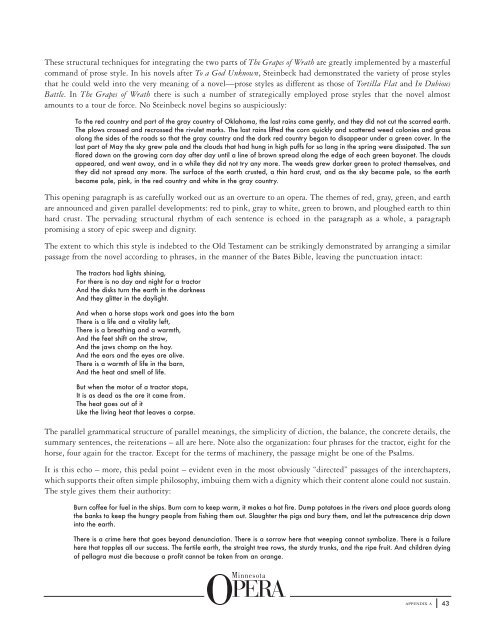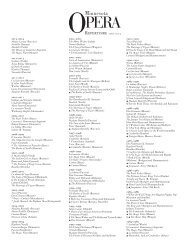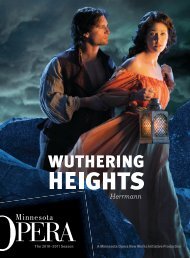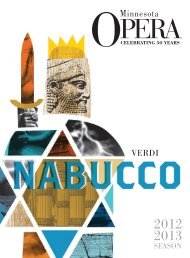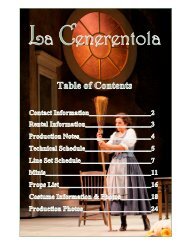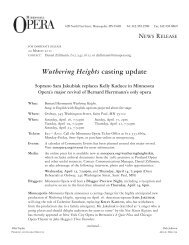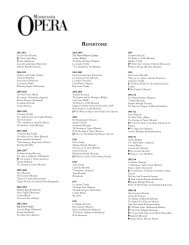Create successful ePaper yourself
Turn your PDF publications into a flip-book with our unique Google optimized e-Paper software.
These structural techniques for integrating the two parts of The <strong>Grapes</strong> of Wrath are greatly implemented by a masterful<br />
command of prose style. In his novels after To a God Unknown, Steinbeck had demonstrated the variety of prose styles<br />
that he could weld into the very meaning of a novel—prose styles as different as those of Tortilla Flat and In Dubious<br />
Battle. In The <strong>Grapes</strong> of Wrath there is such a number of strategically employed prose styles that the novel almost<br />
amounts to a tour de force. No Steinbeck novel begins so auspiciously:<br />
To the red country and part of the gray country of Oklahoma, the last rains came gently, and they did not cut the scarred earth.<br />
The plows crossed and recrossed the rivulet marks. The last rains lifted the corn quickly and scattered weed colonies and grass<br />
along the sides of the roads so that the gray country and the dark red country began to disappear under a green cover. In the<br />
last part of May the sky grew pale and the clouds that had hung in high puffs for so long in the spring were dissipated. The sun<br />
flared down on the growing corn day after day until a line of brown spread along the edge of each green bayonet. The clouds<br />
appeared, and went away, and in a while they did not try any more. The weeds grew darker green to protect themselves, and<br />
they did not spread any more. The surface of the earth crusted, a thin hard crust, and as the sky became pale, so the earth<br />
became pale, pink, in the red country and white in the gray country.<br />
This opening paragraph is as carefully worked out as an overture to an opera. The themes of red, gray, green, and earth<br />
are announced and given parallel developments: red to pink, gray to white, green to brown, and ploughed earth to thin<br />
hard crust. The pervading structural rhythm of each sentence is echoed in the paragraph as a whole, a paragraph<br />
promising a story of epic sweep and dignity.<br />
The extent to which this style is indebted to the Old Testament can be strikingly demonstrated by arranging a similar<br />
passage from the novel according to phrases, in the manner of the Bates Bible, leaving the punctuation intact:<br />
The tractors had lights shining,<br />
For there is no day and night for a tractor<br />
And the disks turn the earth in the darkness<br />
And they glitter in the daylight.<br />
And when a horse stops work and goes into the barn<br />
There is a life and a vitality left,<br />
There is a breathing and a warmth,<br />
And the feet shift on the straw,<br />
And the jaws chomp on the hay.<br />
And the ears and the eyes are alive.<br />
There is a warmth of life in the barn,<br />
And the heat and smell of life.<br />
But when the motor of a tractor stops,<br />
It is as dead as the ore it came from.<br />
The heat goes out of it<br />
Like the living heat that leaves a corpse.<br />
The parallel grammatical structure of parallel meanings, the simplicity of diction, the balance, the concrete details, the<br />
summary sentences, the reiterations – all are here. Note also the organization: four phrases for the tractor, eight for the<br />
horse, four again for the tractor. Except for the terms of machinery, the passage might be one of the Psalms.<br />
It is this echo – more, this pedal point – evident even in the most obviously “directed” passages of the interchapters,<br />
which supports their often simple philosophy, imbuing them with a dignity which their content alone could not sustain.<br />
The style gives them their authority:<br />
Burn coffee for fuel in the ships. Burn corn to keep warm, it makes a hot fire. Dump potatoes in the rivers and place guards along<br />
the banks to keep the hungry people from fishing them out. Slaughter the pigs and bury them, and let the putrescence drip down<br />
into the earth.<br />
There is a crime here that goes beyond denunciation. There is a sorrow here that weeping cannot symbolize. There is a failure<br />
here that topples all our success. The fertile earth, the straight tree rows, the sturdy trunks, and the ripe fruit. And children dying<br />
of pellagra must die because a profit cannot be taken from an orange.<br />
appendix a<br />
43


